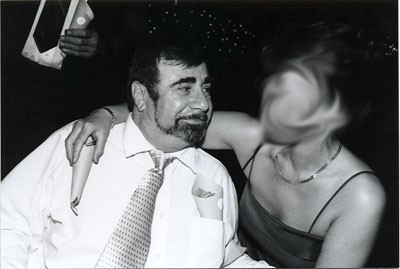Page 3 of 7
"SWAT Officer Kimbell and a second SWAT officer issued commands for Mr. Ehrenburg to show his hands," the statement says. "Mr. Ehrenburg failed to comply with the commands."
There's one major problem with this scenario, Ehrenburg's wife and friends say. Ehrenburg's electric wheelchair was charging in the garage at the time, and he was using the manual one. It would be impossible for him to move forward in his wheelchair without both his hands in plain sight on the wheels. Had he used just one hand, he would have gone in circles.
According to the statement, SWAT officers then noticed a gun in Ehrenburg's lap. They begged him not to reach for it, but Ehrenburg did and "raised the gun with his hand towards the SWAT officers." Kimbell then fired three shots at him, striking him twice and killing him.
That's the official version of events.
In the version of events described on police radio tapes, after SWAT bursts through the door, Ehrenburg is first sitting and then laying down in the living room and no wheelchair is mentioned.
"Right now he is sort of laying down," an officer says on the tape. "They can only see one hand. They are trying to get him to sit up so they can see both hands."
"We can port another window right here and see straight into him," a male voice says.
"Yeah, or you can just (sigh) thinking you can take it to him," another male voice says.
"I think he is half in the bag," the first male voice says. "I don't know if he understands what the hell we're doing here."
"Go in behind the shield," the second male orders and a loud beep then drowns out all other sound for about 20 seconds.
"Alex!" another voice yells. Then another voice orders someone named "Glenn" to "drop a bang" through a back window. A "bang" or "flash bang" is a term for devices commonly used by SWAT teams that are designed to stun and temporarily blind an assailant with a powerful sound and flash of light. One minute and 29 seconds later, officers can be heard on the tape yelling "Medic!"
In the first, official version of events, officers never enter the house, never throw a "bang" and shoot Ehrenburg from the doorway. In the second, unofficial version, they are ordered to go into the house behind a bulletproof shield after the front door is opened.
Four different news reporters at three TV stations and the Charlotte Observer all reported that they were told that SWAT officers shot Ehrenburg after officers entered his condo. Days later, the Observer ran a correction saying that Bridges, the police spokesman, had said the officers never entered the condo.

- Courtesy Izabella Skorska
- Alexander "Sasha" Ehrenburg and his wife, Izabella Skorska, celebrate the New Year. Skorska and her husband used to donate to The Police Benevolent Association but she asked us to obscure her photo because she's afraid she'll be targeted if police recognize her in traffic.
Whatever the case, Ehrenburg's death stands out for another reason: Over the last five years, CMPD's SWAT team has intervened in 68 cases, many of them involving criminals who were holed up after they were suspected of committing serious crimes. Ehrenburg is one of only two suspects SWAT has shot during that time and the only one SWAT killed.
Two Sides of a Coin
Ehrenburg's wife and many friends still talk about him with an almost wide-eyed awe and an open admiration for his wicked intellect, which amazed everyone who knew the master's level electrical engineer who worked on nuclear reactors for Duke Energy.
"He was about the sharpest guy we've ever met," says Barnhart, who described being embarrassed from time to time by his inability to keep up with Ehrenburg's vast knowledge of American history and architecture.
His neighbors are still struggling to understand why police killed the man they knew. Ehrenburg was frequently seen piloting his electric wheelchair with an American flag on the back around their Amity Springs Drive area neighborhood off Sharon Amity Road. They say he kept his finger on the neighborhood pulse and always had news to report about what was going on.
He'd warn a neighbor if her car frame looked off balance and was known for fixing and fine-tuning the neighborhood kids' bikes.
"Every kid in the neighborhood liked him," says neighbor Eduardo Romero. "He was always trying to help everybody."
Romero was at home the night Ehrenburg was killed and watched police operate. What he saw angered him.
"The guy was not being a menace to the community," says Romero. "I was more worried about the [police] sniper shooting me than about what was going on."